
- Source: THE NEW YORK TIMES
- Author: EMIL WILBEKIN
- Date: SEPTEMBER 16, 2022
- Format: ONLINE
What Does It Mean to Be a Young, Black Queer Artist Right Now?
‘A project like this is almost a double-edged sword’: A conversation with the creatives who are making the culture — and questioning it, too.
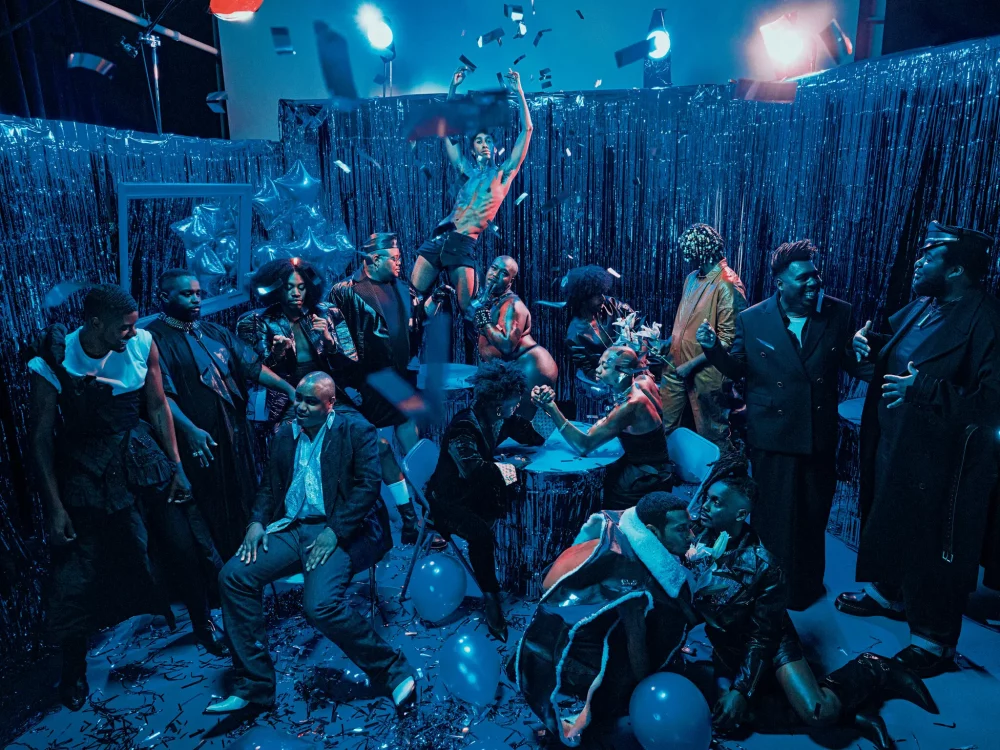
Clockwise from left: DonCHRISTIAN JONES, 32, musician and visual artist; ABDU ALI, 32, musician, writer and artist; JEREMY O. HARRIS, 33, writer and actor; JONATHAN LYNDON CHASE, 32, visual artist; MILES GREENBERG, 24, visual artist; BRONTEZ PURNELL, 40, writer and musician; DEVAN SHIMOYAMA, 32, visual artist; HUGH HAYDEN, 38, sculptor; SAEED JONES, 36, poet; JAQUEL SPIVEY, 23, actor; JONATHAN GARDENHIRE, 29, visual artist; CLIFFORD PRINCE KING, 28, visual artist; ERIC N. MACK, 35, visual artist; EDVIN THOMPSON, 29, fashion designer; D’ANGELO LOVELL WILLIAMS, 29, visual artist. Photograph by Shikeith. Styled by Ian Bradley
“Black men loving Black men is the revolutionary act,” says the filmmaker Marlon Riggs in his 1989 documentary, “Tongues Untied.” For Riggs, who would die of complications from AIDS five years later, the film — made during the darkest days of the epidemic — had “a singular imperative: to shatter America’s brutalizing silence around matters of sexual and racial difference.”
Just 55 minutes long, “Tongues Untied” is freewheeling yet frank, a mosaic of interviews and personal testimony by Riggs and readings of works by friends of his (the poet Essex Hemphill;¹ the writer Joseph Beam²) interspersed with other footage (of Eddie Murphy telling a homophobic joke;³ of Black gay men marching against AIDS). It’s funny about sex and romance in New York, unflinching about the rise of H.I.V. — and when it aired on PBS in 1991, it inflamed the American culture wars, as then-presidential candidate Pat Buchanan soon seized on the project (and on the $5,000 grant from the National Endowment for the Arts that Riggs had used to help make it) to push for stricter content and cultural funding restrictions across the country. After Republican politicians accused Riggs of showing pornography on public television,⁴ he responded with his own Op-Ed in The New York Times: “In this mudslinging match, I along with other gay and lesbian Americans, particularly those of color, have again become the mud,” he wrote. “Because my film, ‘Tongues Untied,’ affirms the lives and dignity of Black gay men, conservatives have found it a convenient target, despite the awards and popular and critical acclaim it received.”
More than three decades later, Riggs’s everyday portrayal of queer Black lives feels just as potent, particularly among a generation of young, multidisciplinary creatives who view the director and his crew as ancestors: “It’s been a key inspiration to my journey in film and visual art,” says the 33-year-old artist Shikeith,⁵ who first gained notice as a photographer, although he works across many media. “It was a huge lesson in how I approach community and collaboration.”
Last year, he proposed creating a portfolio for this magazine that brought his own cohort of rising queer Black male and nonbinary artists into one room, something he felt “hadn’t happened before,” while paying homage to Riggs and his pioneering work. Some of the 24 people featured on this issue’s cover and the following pages had previously met — the playwright Jeremy O. Harris⁶ and Shikeith overlapped at Yale during their M.F.A. programs — while the rest had mostly known and respected one another from afar: The poet Danez Smith⁷ used one of Shikeith’s pictures for the cover of their 2017 book, “Don’t Call Us Dead”;⁸ when Shikeith was a student, he recalls, he bookmarked paintings by Adam Pendleton⁹ that he found online. As soon as the group arrived on set in Brooklyn, the camaraderie was electric: As Smith put it, “Just to get to dance with [the writer and musician] Brontez [Purnell]¹⁰ or sit with [the visual artist] Jonathan [Lyndon Chase]¹¹ and their partner, it felt so right.”
The following day — Aug. 2, which, coincidentally, would have been James Baldwin’s 98th birthday — Shikeith, Harris, Pendleton, Smith and the actor Ato Blankson-Wood¹² (best-known for starring as Gary in Harris’s “Slave Play”) gathered in a New York Times conference room with Emil Wilbekin,¹³ a noted Black gay journalist and writer a generation above theirs, to discuss the shoot, its inspirations, how it feels to be a young, queer artist of color working right now — and, with that, what it means to participate in a project like this in an era when one’s own identity can feel so easily marketed, consumed, erased and, much like Riggs’s art, legislated against. “You think about how communities are formed but also how they’re nourished or not nourished,” Pendleton says. “The mere fact that [many of us] hadn’t met — this speaks to a lack of nourishment.”
What follows are edited and condensed excerpts from that conversation.
Shikeith: I pitched this idea in May 2021, [after] the 30th anniversary of Marlon Riggs’s “Tongues Untied.” I wanted to bring in this specific community of people that I felt were intersecting and collaborating — or had known of each other or influenced each other — who all happen to occupy these identities, very much like the community that Riggs and Essex Hemphill and Joseph Beam had. And even back before that: Think about the Harlem Renaissance and Langston Hughes¹⁴ and Richard Bruce Nugent¹⁵ — all these people who’d been marking their time through collaboration. I felt like that hadn’t really happened with our community yet, and I wanted to celebrate one another, in the midst of all of our individual successes.
Emil Wilbekin: When was the first time that you saw “Tongues Untied,” and how did that affect you?
S.: I made a documentary called “#Blackmendream” in 2014, and I was using Tumblr to get people to see my film when I stumbled upon “Tongues Untied.” It always goes back to Tumblr —
Danez Smith: It was the way!
S.: First I was like, “Damn, somebody beat me to the punch, like, who is this?” And then you see the date, right? It’s one of those moments when you realize there’s a lineage before you. Seeing the film, I had an immediate reaction because I hadn’t really seen anything like that. It’s probably the most-watched film in my life: Every time, I discover something new.
E.W.: For the rest of you, how did it feel to be a part of this collaboration among other Black queer artists?
Adam Pendleton: I have to be honest — I didn’t know what was going on until I showed up. I’m sort of in the cocoon of my studio, which is also my world. I’m always trying to stay off email and devices: I’m willfully disconnected in some strange way. So I only started to piece it all together in real time. Then it hit me what was happening. I was speaking to someone [after the photo shoot], and I said, “It had the strange feeling of something that could be historic.”
E.W.: Danez, what about you? How did you feel yesterday?
D.S.: I’m thinking about this lack of nourishment, or a different kind of nourishment that’s been happening with this community in particular. Finally seeing people who I’ve been so inspired by for so long gathering in that way, I was almost moved to tears.
It’s wonderful that Tumblr was brought up: especially for me, coming from the Midwest¹⁶ and so often living in spaces where there wasn’t an abundant Black queer community, it’s been nourishing to go online and feel that abundance of mirrors and reflections of people who I feel I’m walking alongside. It was really refreshing to have a visual moment: not just the pictures but everything behind the pictures, of sitting in the chair and getting beautified — and the crew looked like us! It was, you know, Black sissies! It was our sister and kin. It felt so right.
I don’t want to shade this other thing I did, but I did a very similar shoot [for T Magazine] about [four] years ago when it was just this large group of Black male writers. And it was cool, I liked it, but it was also this very particular idea about what a Black man was. We were all dressed in suits, and some of us who were more effeminate or more borderless in our construction of Black masculinities were put into this very respectable kind of presentation. And so to come in yesterday and to see that Ian [Bradley]¹⁷, the stylist, had pulled dresses and skirts and it was leather and it was kink and it was free, and Brontez was just walking around in the tiniest [outfit] ever. It was marvelous, you know?
For me, queerness and Blackness both speak to an approach to humanity and to art that is best when borderless, best when we use that queer key to question what is outside of the norm. When something feels special, we feel powerful, and yesterday felt special. In our own studios and practices, maybe we’re free, but we move through these worlds where we corral or edit ourselves in certain ways. To see people like us who make the things we make in The New York Times, I hope it’s not just cute, you know? I hope it’s not just being commodified. I hope it’s saying something about the necessity of the Black queer mind to imagining a progressive, futuristic America.
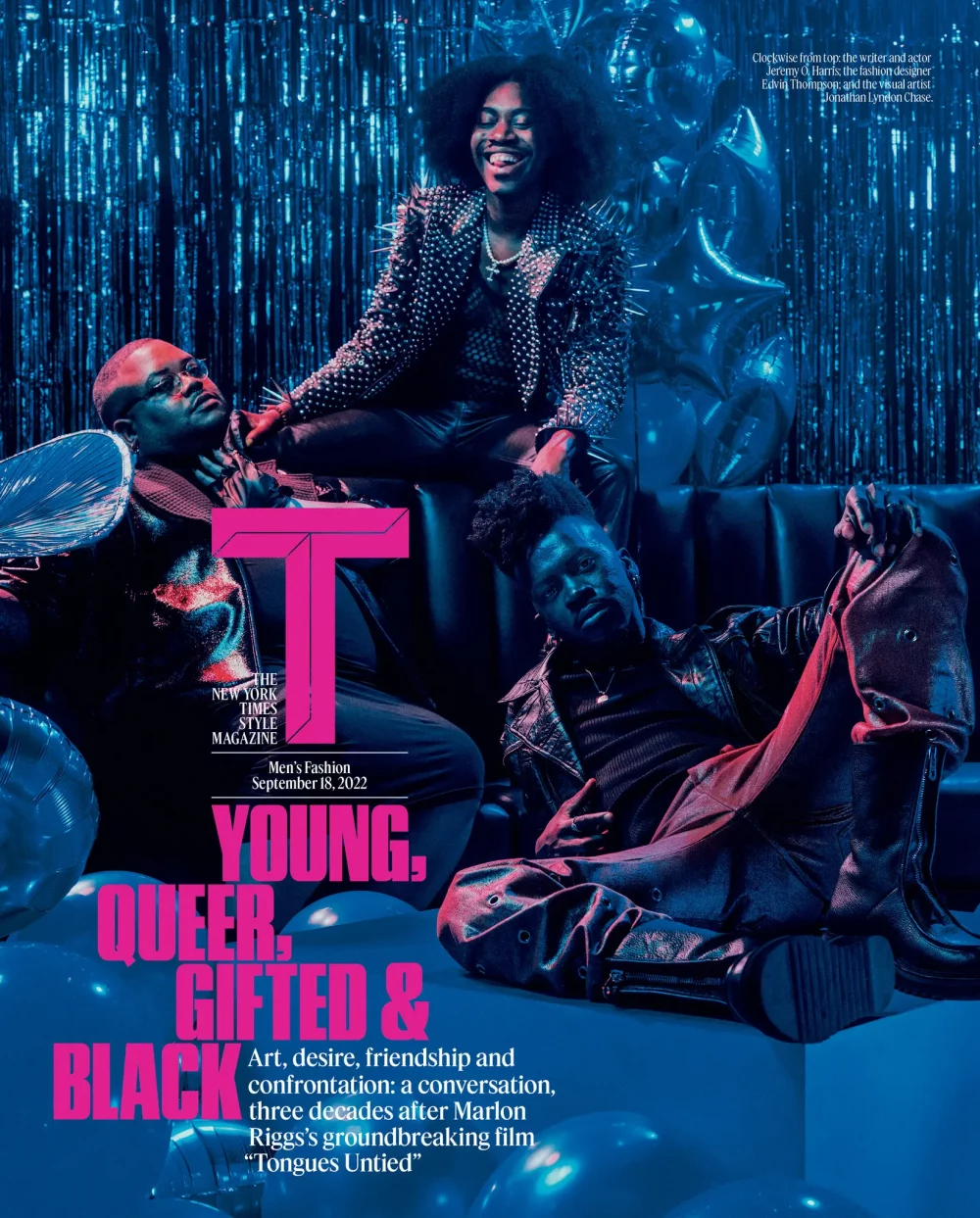
Clockwise from top: JEREMY O. HARRIS, 33, writer and actor; EDVIN THOMPSON, 29, fashion designer; and JONATHAN LYNDON CHASE, 32, visual artist. Photograph by Shikeith. Styled by Ian Bradley
Ato Blankson-Wood: This word “nourishment” has come up a bunch, and I don’t think I realized how hungry I was until I was in that space. I’m really malnourished. And while, yes, Tumblr and Instagram are connective, ultimately, we’re human beings and we crave physical community. I don’t think I’d realized how much I’ve been searching for that, which is interesting because making theater and acting are very collaborative, but there was something about being with people who I felt saw me, who understood something about my journey and my humanity with no effort involved. I was just able to be fed. It’s like someone cooking a good meal for you: It hits so different than when you’re at a restaurant.
Representation is important because, I mean, we all work in our corners of the world, being like, “Who’s going through what I’m going through?” And I think this will be really important to those kids who are in their corners right now, saying, “What is possible? Who is out there for me? Can I be nourished outside of this space?” Instead of taking the scraps of nourishment they’re getting in whatever corners they’re in.
E.W.: A lot of Black queer folks talk about living in isolation. We’re oftentimes in spaces where we’re the only ones, or we’re working by ourselves. So why is this kind of collaboration with other Black queer artists important?
S.: I’ll go back to the thinking behind this [project]: In 2020, I lost my grandmother. At the same time, we were heading into complete isolation with the quarantine. Intimacy was ripped away from me. I was living in Pittsburgh — well, I still live in Pittsburgh — and there was just no friendship there, no romance, none of that. A lot of desire for doing this was birthed from that, alongside the Marlon Riggs thing. Like, if not now, when? People are dying. People are just going away. How can I say, “I value you. I want to be around you”? It’s interesting what comes out of grief, for me, in my own little world, and how a moment like this could really transform that.
E.W.: What does it mean to be a young, Black queer artist working today?
A.B.-W.: For me right now, it’s about lineage. I feel an investment in what my queer lineage is, in what my Black lineage is, in how those things make me. I have felt like I’ve been floating, and this connection to lineage for me has been really theoretical. As I’ve learned more about these cadres of Black queer men, that’s led me to a hunger for that in real time. Lineage and community: Those two things are what I’m most focused on.
D.S.: I love that thought about lineage, and it’s really about creating a lineage. And I’m also thinking about the canon going forward. We have the Langston Hugheses and the Bruce Nugents and the James Baldwins, but they were rarities. When I think about what it means to be a Black queer writer, I don’t feel like a rarity — I know too many others of us across the genres. I’m not the only one. If you don’t like my Black poetry, there are 80,000 others to go read, and they all write good and different. But it’s up to us to be in community, and collaboration looks a lot of different ways: Collaboration is Saeed Jones¹⁸ telling me to keep going on this little poem that became one of my best works. Collaboration is Phillip B. Williams¹⁹, who’s been a rock in my work, always encouraging rigor and innovation and not being satisfied. Collaboration is Jayson P. Smith²⁰, back in 2014 or 2015, texting our Black sissy group chat a feature on Shi’s work, and we all picked our book covers out of that.

The poet and writer Langston Hughes on the steps in front of his house in Harlem, June 1958. Robert W. Kelley/The Life Picture Collection/Shutterstock
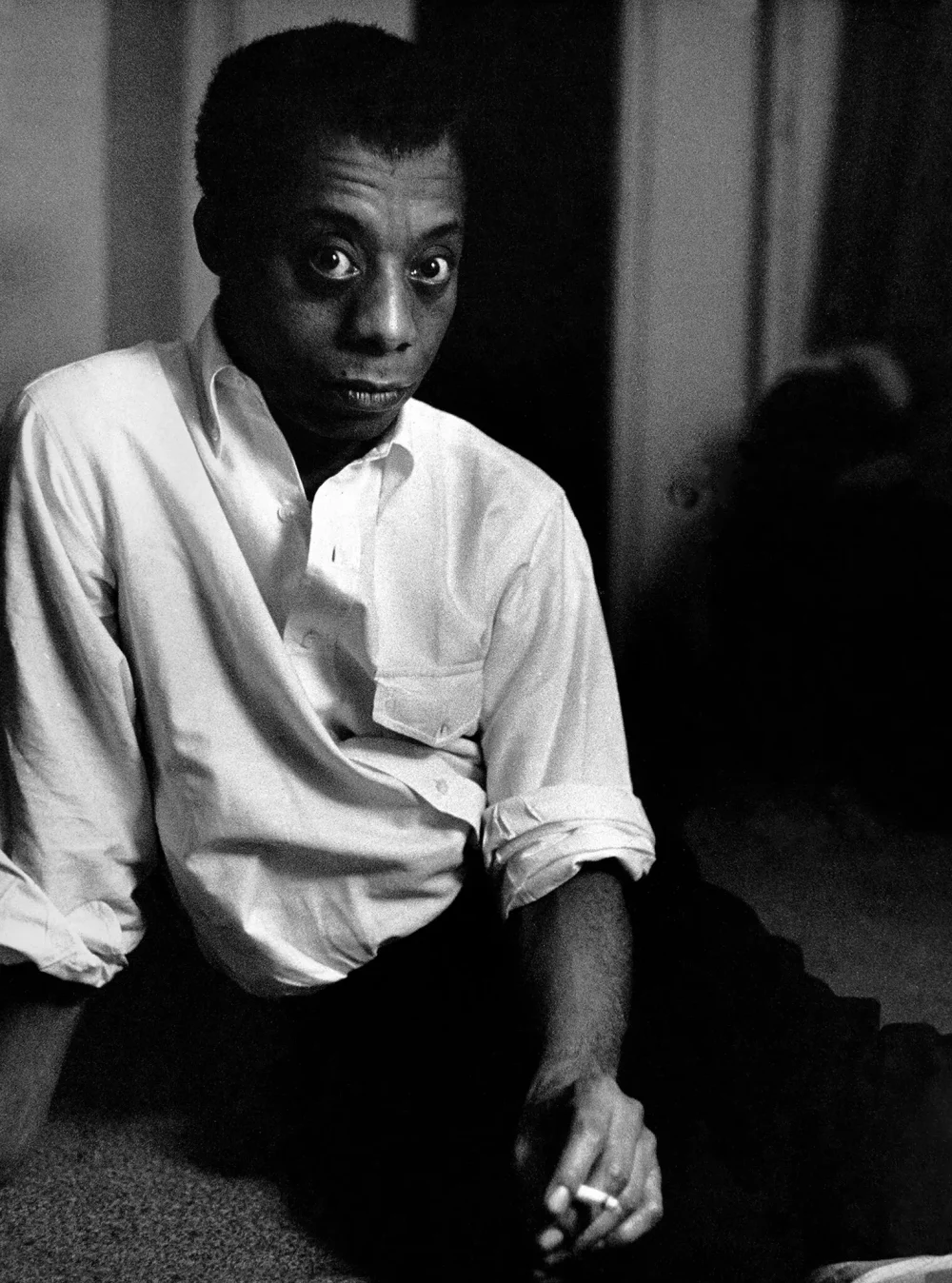
The writer James Baldwin, circa 1963. Robert Frank/Condé Nast/Shutterstock
So just keeping each other focused on artistic freedom, on play, and also recognizing that by making the work that our ancestors maybe didn’t have the space or the funds or the peace or the community to create, that we’re also starting a canon that’s been sparse, that’s been wiped out by H.I.V./AIDS. We’re the first truly abundant moment of what’s been a long canon, a canon that has all these silences within it. And how do we make sure that all these babies find themselves, that they’re not coming up empty when they’re looking for themselves in the libraries and on the screens and on the walls of these museums? We’re making ourselves legible to them so that they know that they have a past; that they exist; and that they damn sure have a future.
Jeremy O. Harris: Something that’s been very important is having Black queer and Black femme friends from a lot of different generations — people who’ve told me about artists I would never have known about, or who no canons wanted to invite in, but who were abundantly a part of the community and influential inside of the community. Like Julius Eastman²¹, who’s one of the most influential composers to me, a seminal figure of 1970s and ’80s composition. He was a Black queer man and died basically alone, because he had too much mouth and was too interesting for people to keep inside of any institution. And then you think about so many of these Black queer poets in the 1920s who were writing phenomenal work.
Now what’s great is that I get to meet all these young queer artists: When I did this play called “A Boy’s Company Presents: Tell Me if I’m Hurting You,”²² almost the entire cast was out gay boys between the ages of 15 and 20. Each chapter was named after a queer legend who was influential to my writing. Introducing these kids to writers they had no idea about, like Essex Hemphill, was a phenomenal thing because that’s a part of this: Holding hands with our ancestors who may have passed from H.I.V. or were happenstances of the drug era and a litany of other calamities over the last 400 years.
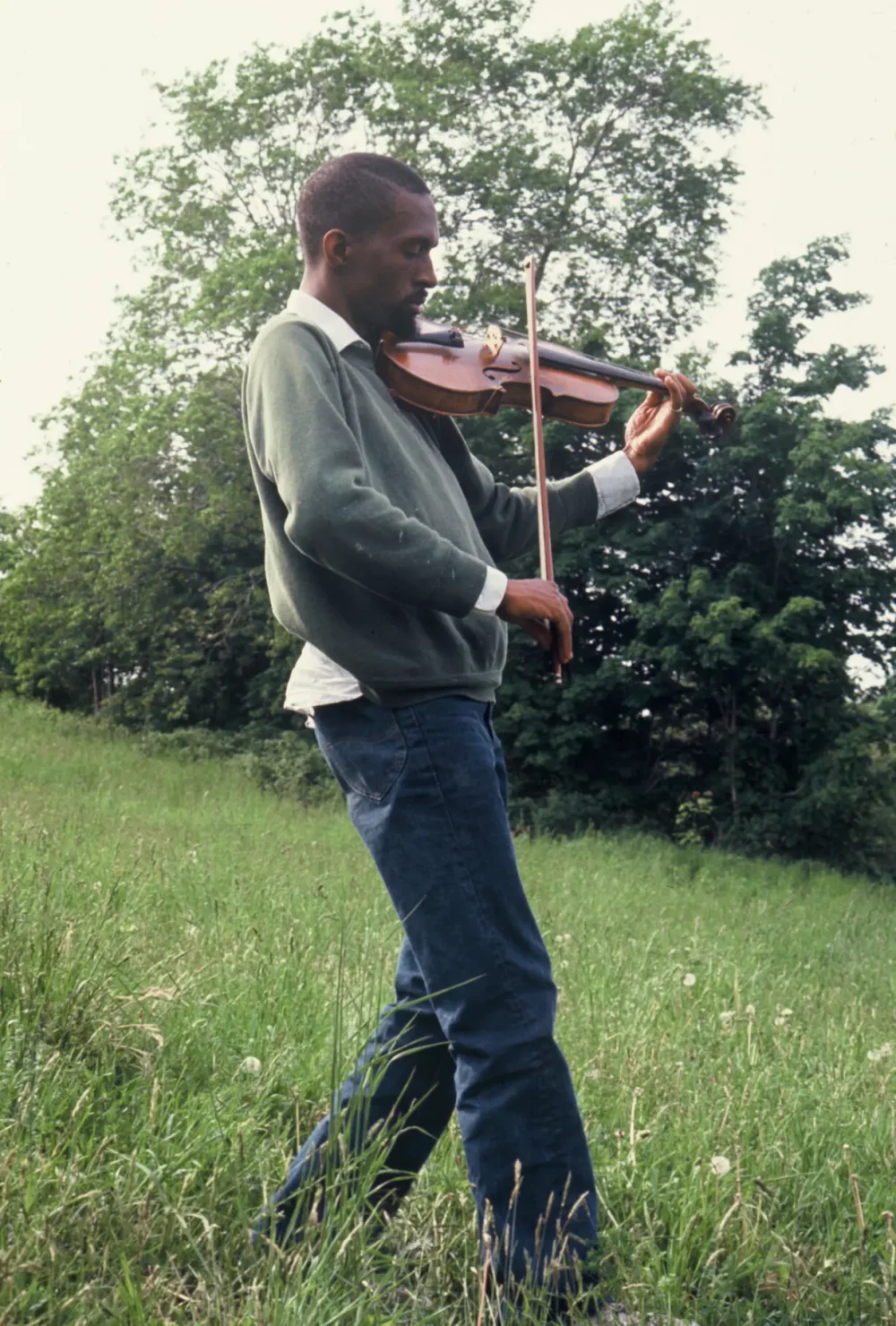
The composer and singer Julius Eastman playing the violin at Griffis Sculpture Park in East Otto, N.Y., during a 1975 rehearsal by the S.E.M. Ensemble. Chris Rusiniak
E.W.: Jeremy, what does being a young, queer Black artist mean today to you?
J.O.H.: I finally feel free from having to articulate it all the time. It [once] felt very powerful to articulate loudly and proudly that I am Black, I am queer, I was raised poor, I was raised in the South²³ — every part of my identity became these pillars upon which I stood. And now, because of the way that capital has shifted inside of this product-based moment, I get more nervous about the necessity of explaining every pillar. I’m realizing the things I used to say out loud were always there; people just pretended they weren’t. And so I’m standing with my head held high. Like, it’s very apparent that I’m someone who was not raised among gilded halls but can walk them freely now. I’m not someone who’s going to marry a woman and hide away my true self. So I don’t need to articulate that to you. And if you want to act obstinate or ignorant, that’s up to you.
I’m excited about creating a pathway for young people so they don’t feel as though they have to sell their skin or their body or their history in order to tell their stories. I think the selling of some of those things — the consumption of some of the things — starts to make a lot of us feel crazy. I want to disrupt that. I just read this amazing Chester Himes²⁴ novel from the 1940s, and I was like, “Oh my God, were me and Chester Himes cousins?” Like, “Were we working in similar modalities?” That was a book where he was making sense of the modern moment and satirizing it for a lot of different people in a lot of different ways. But in every way it was unexpected for a Black man of that time. I’m really excited to continue to explode expectations.
S.: That takes an immense vulnerability because, like you said, when we all started to get noticed, we were just trying to tell our stories. I think of myself in the studio recently being like, “I just feel like doing this monochromatic blue painting.” There’s so much anxiety about doing that, and you just gotta say to yourself, “I’m going to be this spill,²⁵ I’m going to be this borderless representation of myself, this abstraction of myself.” I want to keep spreading out and expanding — just be on your Ellsworth Kelly, go ahead, do your thing, it’s enough.
D.S.: What happens when your work gets to move past argument — especially arguing for validity, arguing for existence, the legality of you? We’re in this moment where — I mean, we’re still in the midst of Black Lives Matter, which feels like an obvious statement to everybody in this room, but that simple idea, that Black lives are important, was a controversial statement in 2014. We’re in a moment where Roe v. Wade has just been overturned; where these [people] are thinking about taking away gay marriage. I’m wondering, “Did we get too free?”
Like you being able to make a monochromatic painting, Shikeith: That’s a comfort that comes once your career’s in a streamline. I think all of us in this room feel like we’re at a place where we don’t question if the art is going to keep paying the rent because we trust ourselves to still have ideas. It’s nice to know that people have decided that I have something to say and that that leads, honestly, to capital. But what happens when you’re not resisting? What happens if you’re just existing? And even in that, can we still struggle toward a greater freedom but not have to prove ourselves?
A.P.: Adjectives are terrible, but generosity and legibility are important. And what I mean by that is: A project like this is almost a double-edged sword, in the sense that any instance where you’re identified is a terrible moment, actually. When you’re claimed as something — when you’re named as something — that’s not necessarily a moment of celebration or liberation. And that’s kind of what this being released into the world will mark. It’s funny because I actually never thought about any of this, so when you keep saying “Black,” “queer” — that’s not the language I used when I thought about myself as an artist. I was just like, “I’m an artist.” That was it.
I never attached other language to that word. There’s a bit of a paradox here: To announce ourselves to the world as Black and queer is also a problem. And I think it’s important to acknowledge that and to articulate why it’s a problem, because what, of course, will happen is: “Oh, look at them,” you know? And the “them” is the problem, because how can you really see what one person does, what one person contributes, when it’s a collective? It’s a lot more work to get into the particularities of what one individual contributes and how they contribute, how they theorize, how they conceptualize, how they formalize, when we’re dealing with people and their ideas on an individual rather than a collective basis.
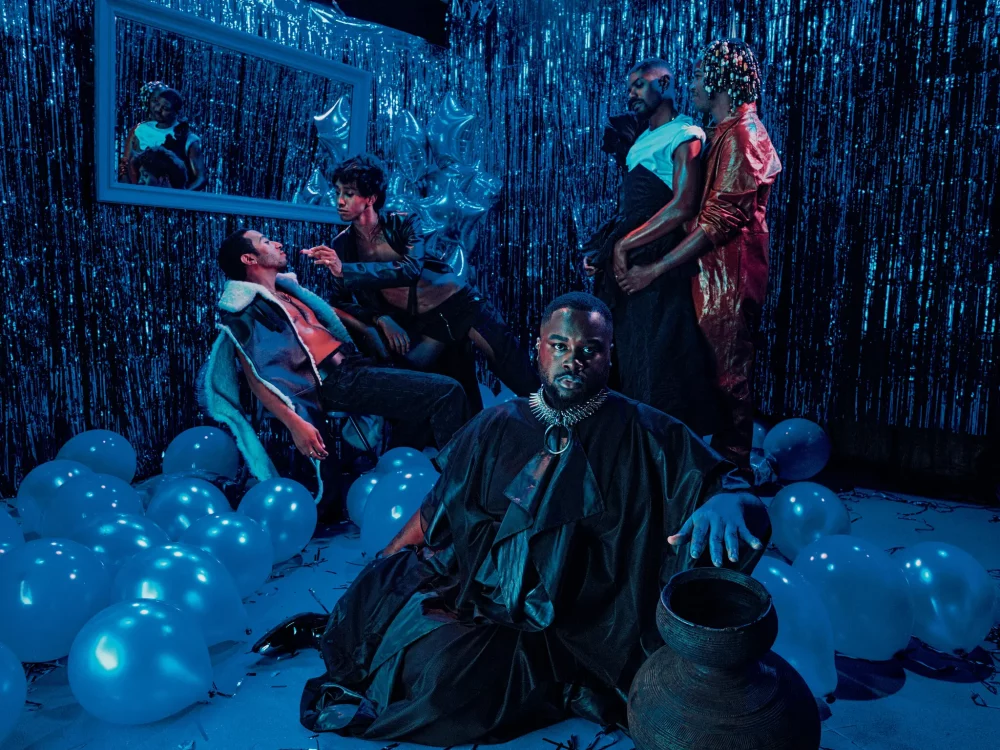
Clockwise from left: CLIFFORD PRINCE KING; MILES GREENBERG; DonCHRISTIAN JONES; HUGH HAYDEN; and ABDU ALI. Photograph by Shikeith. Styled by Ian Bradley
E.W.: So how do you find that balance? Because part of what you’re saying is, “We don’t want to be identified just as X, Y and Z.” But at the same time, it was great nourishment for you to be in community as Black queer folks. So where’s the tension there? You want to see yourselves, right? You want to come together as Black queer folks, but you don’t want to be labeled as that. How does that work?
D.S.: I don’t know if we all agree.
A.B.-W.: We don’t have to. And I think that feels new, oddly enough. There’s this idea that there’s a right, there’s a wrong, these ideas are allowed, these aren’t. Which, theoretically, yes, it’d be nice if people were able to come to some sort of harmony. But that’s not how the world or any sort of natural process actually works. The ability to have conflict inside of this community is another beautiful step in our evolution, in our ability to just be.
D.S.: I feel like what Adam was talking about sort of goes against representation, in a way, which I appreciate. Or not representation, but against the stagnant nature of these identity markers —
A.P.: It does go against representation. That’s what I’m pushing.
D.S.: I love what Adam is saying because I don’t want my work to be seen as Black queer objects, unless I’m telling you that’s how to look at it.
A.P.: In a strange way, The New York Times doing this is the problem. Whereas if you put these artists under a different banner and it’s buried in paragraph 20, “Oh, and he’s queer,” but actually we were saying, “Look at these 10 artists, and they’re just really important,” that would feel like an evolution to me. That would feel like the [more] radical gesture. I’m sort of tired of announcing the problem, or problems as solutions. I just want to move on.
J.O.H.: What I was articulating was less, “I don’t want to be seen as Black. I don’t want to be seen as queer.” I’m saying, “Those are evident.” Like, if I’m on the cover of a magazine, the people are like, “Who’s that Black gay man?” They’re never going to not see me as [that]. They might not clock that I’m from the South, or that I’m poor — or that I was raised poor. I’m not anymore! But I was.
Representation was always just a political tactic, right? It was like, let’s say representation matters because we’re seeing the only people being represented are white, straight cis people on TV and in magazines. And in the ’70s, one of the tactics was that all the sexiest thought was coming from Black people — these articles in GQ talked about the sexiness and vibiness of our thoughts.²⁶ Then, in the 2000s, we were in a very violent post-9/11 society, and there was this rash of public shootings that we could film, so the new tactic became to talk about identity in this way that was almost in reference to 1960s civil rights stuff but was more of a hashtag. What’s frustrating now is that the people in power are changing their tactics, and that’s why I think identity discourse feels gross and cringe now: Because the white [folks] who don’t want anyone to be free have figured out the tactics of liberation.
I’m excited about finding a new tactic of subversion. We’re in the 2020s now; in the 1920s, Surrealism really took the girls for a run. So what does a Black Surrealist moment look like? What does the Surrealism of 2020 look like, wherein my identity is also my zodiac sign? My identity is this juice that I crafted myself this morning. That’s what I’m reaching toward when I say I’m tired of a conversation about being Black and queer.
A.P.: Well, it’s almost like your silence is a part of your identity.
J.O.H.: Silence is always going to be hard for me, but. … [All laugh]
A.P.: I was thinking about something that Ruby Nell Sales²⁷ said. After Jonathan Daniels,²⁸ the white student, colleague, fellow protester, jumped in front of a bullet for her, she took a vow of silence, and I asked her about it six months ago, and she said, “I didn’t want to become the thing that tried to kill me.” I feel like that’s analogous to what you’re saying — if you think about silence as a kind of technology, as a kind of liberatory force or mechanism to exist beyond the parentheses. I’m thinking, like, “Let’s see, if this was an article about the future of abstraction, but it was all white men,” right? No one’s going to say, “Four straight white men on the future of abstraction.” But if it were four Black artists, they’d say, “Black artists on the future of abstraction.” You never actually get to claim all the space. You only ever get to claim a part of the space. And I want all of it. I don’t want to be “Black in abstraction.” I want to be abstraction.
J.O.H.: That allows us to be fully human and colored in all these different ways, right? Because Black is not the only part of our skin. There’re all these different tinges — but that’s an entirely different conversation. There’s something to the fact that our seismic makers can be slid away from the center of the discourse.
I think Adrian Piper²⁹ is the best performance artist ever, period. Like, if it’s her and Marina Abramović,³⁰ she’s beating Marina, there’s no question about that for me. And yet people will often say she’s “the best Black woman” — she’s not even “the best woman,” she’s “the best Black woman performance artist.” And I wonder if that’s a way we have self-limited ourselves.
A.P.: Too often, we accept the invitation we’re given. You accept it because you have to — but, also, what else is there? You have to wade through all this crap first, you have to offer the rejection before you can get to the story you want to tell. Because there’s only so much time. There’s only so much energy. There’s a word count. There’s an image. It’s like, “No, but I need 10 images and 10,000 words.” There’re these very pragmatic blocks that you’re trying to move around and break down and reconstruct before you can get to what you want to say in the first place.
E.W.: I wonder if it’s about naming it and claiming it. Doing a shoot like this, it’s all these Black queer artists together, and that’s what y’all are, right? Does that then open up space to be like, “I’m a dope poet. I’m an amazing visual artist. I’m a great actor, a great playwright”? As I think about this from an ancestor’s point of view: How many Black queer folks were erased, or were never given credit for the work that they did?
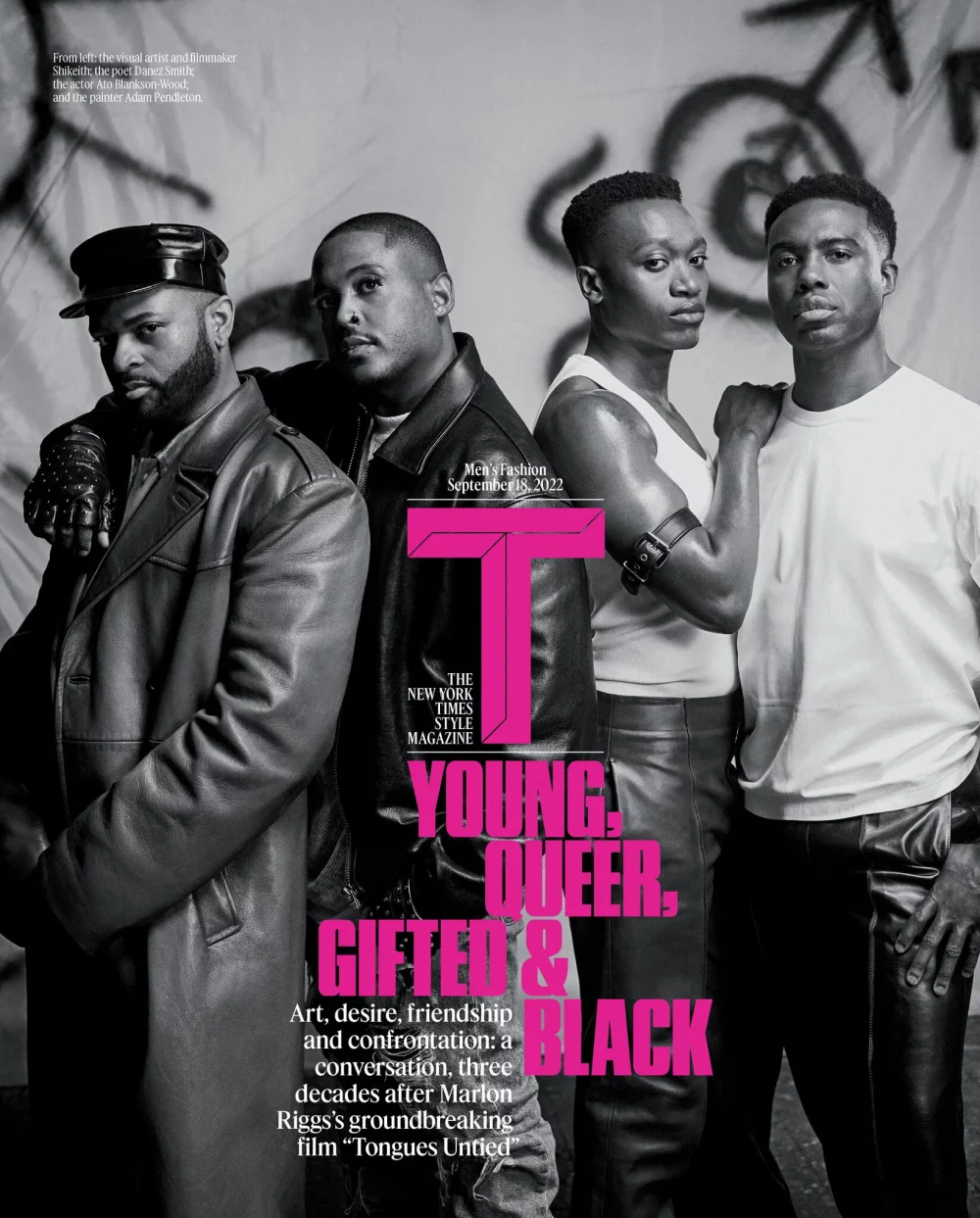
From left: SHIKEITH, 33, visual artist and filmmaker; DANEZ SMITH, 33, poet; ATO BLANKSON-WOOD, 38, actor; and ADAM PENDLETON, 38, painter. Photograph by Shikeith. Styled by Ian Bradley
D.S.: That’s the thing: We can fight individuality from this space of representation, right? Or from group gathering — look, yesterday was beautiful. And, sure, it’s a lens. And lenses are complicated. I’m not interested in that fear of what my naming of my communities does in somebody who was already going to be dismissive. I want to be free to celebrate and to gather. I want to be free to think about myself in a Black queer context, and also outside of it. I want the freedom to gather with Black queer men and say, “Look at this,” and the freedom to gather with people who look nothing like me and also say that. It’s also very limiting to look at what happened yesterday and think that we all make the same [kind of work]. There was such a diversity of styles in that room — of genre, or even within the genres, right? Like, no two bitches write the same, paint the same, sing the same. So don’t let the Black queer shoot — don’t let that room be the end all, be all.
J.O.H.: I think this conversation about identity is very different than the shoot, where I was excited about being a character. I was told it was a celebration of Marlon Riggs; inside of that, I’m not like, “Oh, I’m not Black.” I’m like, “Yes, I am ‘Brother to Brother.’³¹” But when it’s written down, it becomes something different. Words take on different power on the page.
A.P.: People look at the images, but they don’t read the article. So it’s sort of like context but no substance, or substance but no context.
A.B.-W.: When there’s this idea that I have to say, “I’m Black and queer,” or even feel the impulse to loudly say it, I’m like, “Who is this for, ultimately?” Because the people I want to be in conversation with — in collaboration with — they just see it. They understand it on a deeply visceral level. And so sometimes I’m like, “Am I playing a game that I didn’t want to play and didn’t choose to by needing to tout my Blackness and my gayness?” I am trying to figure out that relationship. Specifically, inside of acting there’s a thing where you’re like, “I have to get to the thing to make this life.” And as I’ve gotten closer and closer, I’m like, “Oh, there is no way that that thing can hold my Blackness and queerness.” It’s not in service of that thing. And so now I’m wondering about how my practice expands in order to move into spaces that I feel can actually hold them.
S.: Blackness exceeds representation anyway. The fun thing about yesterday was that we were time traveling, we were doing all these interesting things within the images. And even the idea of putting it all together was not just thinking about, “Oh, this person is Black and queer; this person is Black and queer,” which is the thing that, no shade, the editors were trying to do. And I’m just like, “No, these are the people that I’m in community with. These people are not going to want to be a part of this — I’m just telling you all now — because it’s different. You know, they might exist in these identities, but this is the family. These are people that I love or am inspired by.” And the oversimplified language just kind of messes that all up, you know? What was generated yesterday can’t be put into words.
But the headline, the headline! We all get the same headline: “This Black [Gay Man] Is Challenging Black Masculinity.” I always joke about it with my friends. We’re making so many different kinds of things and we just get boxed in, and it’s so frustrating. I would rather just have the photographs, but I’m glad that we’re having this conversation. Y’all know I’m soft-spoken, I stick to my visual language, but y’all are putting into words something that I felt, that I was like, “I hope that they say that,” because I know that y’all are wordsmiths. And y’all are saying it. And it’s something that I feel will encourage this community that I was talking about, that’s coming together in the midst of monkeypox and Covid. We need to be able to exist in Black queer space, but let us hop around, and don’t use reductive language to keep bounding us in.
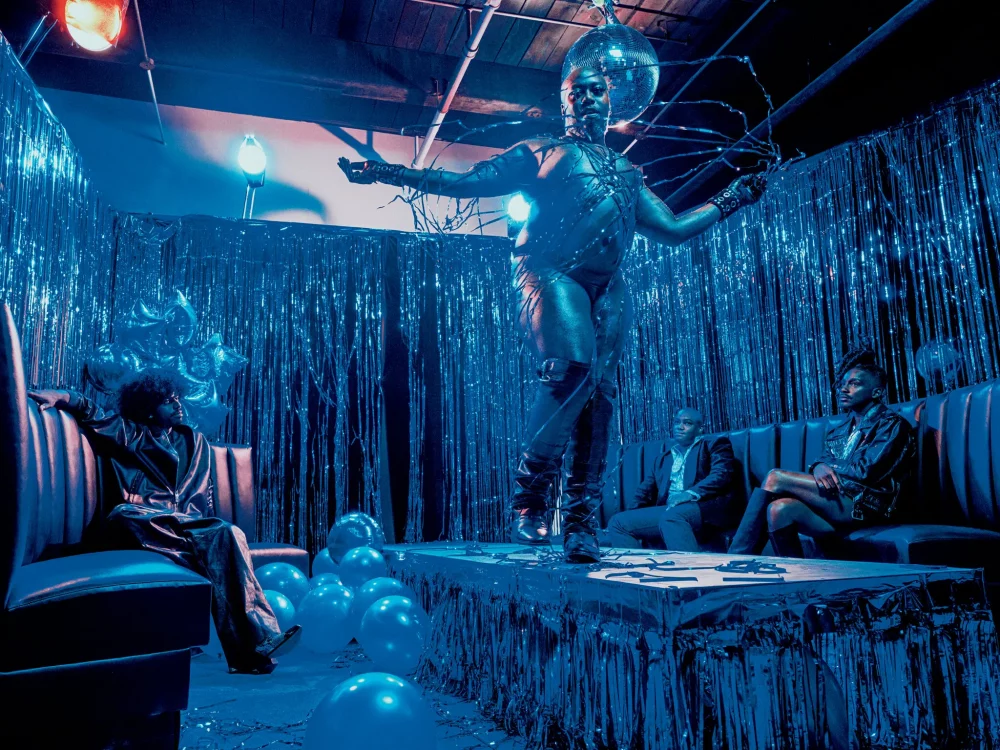
J.O.H.: One of the things I worry about is that the little gay boys and girls I’m friends with don’t meet people their age IRL. They only know people through their oomfs, right? The oomfs run the world.
D.S.: What’s “oomf”?
J.O.H.: An oomf is an “O.O.M.F.” — “one of my friends,” as in someone you know only in a digital space, from Twitter or Tumblr.
D.S.: Oh, yeah, one of my followers.³²
J.O.H.: The idea that people are discovering their sexuality and their expressivity online is a beautiful thing. I have a 12-year-old niece who’s a she/they pansexual, and she learned about all of those things on TikTok. But there’s also a troubling thing where people become only what you see in 160 characters.
A.P.: But, Jeremy, it’s even more than that because those spaces are mediated spaces.
J.O.H.: Yes.
A.P.: So if you find your way into something, you might never find your way out. It becomes a prison.
D.S.: Look, if I can make it out the church, they can make it out of Twitter. [All laugh] So I’m not really worried about them in that way. I am informed by who I was at 16 and am no longer that bitch — I was a straight football player. Look how far I’ve come! You see these heels?
J.O.H.: But the ecological realities of where we are now do make certain things feel more dire.
D.S.: We’re probably homotechnic at this point: We have as much of a digital life as we do a fleshy one. But I have a hope that will have its limitations for them, right? They have to engage with their body and the bodies of others, and the information that comes from that.
A.B.-W.: Maybe I’m projecting, but there’s an implicit coolness and detachment around these digital spaces that doesn’t actually feed into wanting to connect. I’m also old enough to have fully existed before any of this, and to understand from a young age the value of connection and to sort of see it dwindle a bit. I also feel I’ve been pushed into a space where living this digital life isn’t necessary in some ways? It’s a bit of a prison, but I have the key and can figure some way out. Yesterday was a little bit of a glimpse of letting myself out — yet I wonder how that continues.
J.O.H.: Yeah, it was so exciting to see some people you only know in two dimensions in three dimensions.
E.W.: I want to go back to Marlon Riggs and that era: the work that he did, the work that Isaac Julien,³³ Essex Hemphill and Joseph Beam did. One in two Black men who have sex with men may contract H.I.V. in their lifetime,³⁴ and we’re in the middle of this crazy monkeypox moment. A lot of their work was about their art as activism. Do you all feel like you’re being activists?
D.S.: I really question that. As [someone] who is often put into the “Danez’s poetry is activism” box, I hate that. I think I can have a political mind. I think I can have a politics to my work. And I don’t think that necessarily makes me an activist, because my activism costs $16.99. My activism is free from the library. It’s free when it’s published online, but it’s not in the streets. It could be an inspiration for activism. One of my active hopes is that my work is a fuel for people who desire to make change. But me making a metaphor is not activism — it’s a craft, it’s work. There might be a political hold behind it. But I really am troubled by the idea that making art is activism. Making art is my career, making art is my craft. It is play for me. The real world often intersects with and is often the topic of my art. I think being who I am — Black, gay, nonbinary, H.I.V. positive, all this other [stuff] — factors into my work being seen as political, but my work ain’t changing policy. My work ain’t making no demands. Maybe my work is activism when it shows up on a sign at a protest. Maybe my work is activism once it has motivated or transfigured somebody who is doing that work. But my work is my work. Activism is when I put my body, money and attention behind something that’s actually pushing back.
J.O.H.: I agree with you that artists need to make an individual statement about whether their work is or isn’t activist. But I believe there are artists who are activists. Like Marlon Riggs: He created a work that was discussed in the halls of Congress, that disrupted policy. Literally, because of him, PBS lost [some] of its funding — we could have lost all of the N.E.A. because of this one man³⁵. He made [people] think in a way they didn’t want to think. So then ideas about Blackness, queerness and H.I.V. were being talked about on C-SPAN,³⁶ right? That’s something that very few artists get a chance to do. There are so many other artists that one can name who’re doing political work.
Much like you, Danez, I think that my work at this moment doesn’t make me an activist. I’m someone who, inside of the small microcosm of New York City commercial theater, has had aspects of activism inside my work, as far as who sees theater, how they see it and who gets access to it. But on a grand, systemic societal level, my work hasn’t gotten there yet. But I aspire to that — at some point. That labor also requires me to take more sacrifices that I, up until this point, haven’t been able to make, but I’m hoping to reach toward those things.
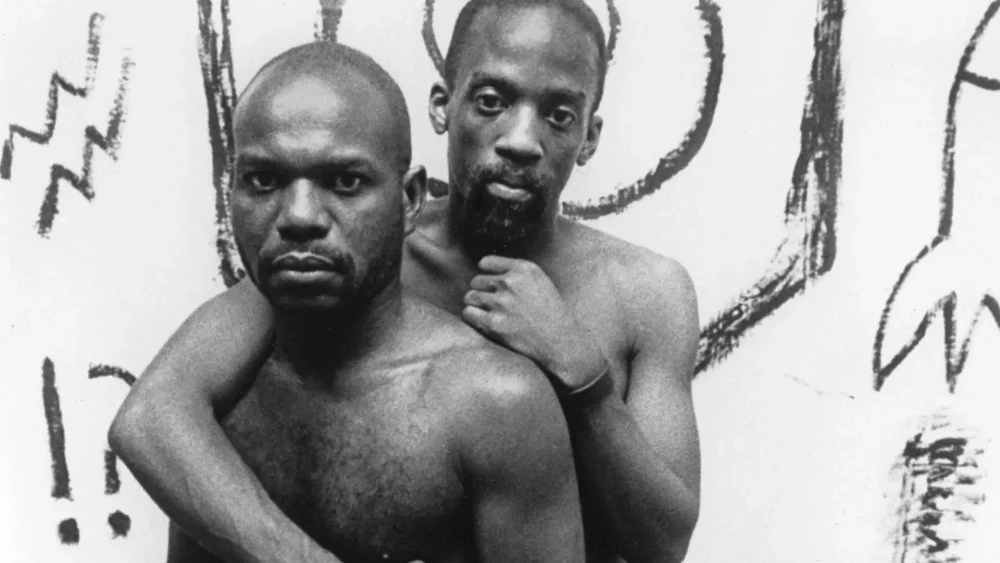
Riggs, left, and the poet Essex Hemphill in a still from “Tongues Untied.” Signifyin' Works/Frameline Distribution
D.S.: I think you saying that you had this play that was staged with, you know, out gay Black 15- and 16-year-old kids, that is activism, that’s community work.³⁷
J.O.H.: Just existing isn’t always an act.
D.S.: Well, that’s what I mean, though. What you do with that art, that can be activism, right? I don’t think all visual art is activism, but if you put that piece of visual art in the right place, maybe I’m down for a conversation about how that’s activism.
A.P.: I laugh because I thought, “How wonderful that would be if all visual art were activism.” The absurdity of it — it’s almost comical. But if you limit what is activism, that plays into certain forms of violence. Some part of me wants to claim more than less because maybe the more will eventually overwhelm the prospect of less. So if I claim more as a kind of activism, I’ll get more.
A.B.W.: I hear what you’re saying — I love that.
J.O.H.: I just feel like activists should gatekeep more. But I agree with you. The best class I took — well, it wasn’t even a class: There’s a thing called Hot Topics at Yale,³⁸ and they did one called Theater of Resistance, where they had all these people from Russia and Poland and the Middle East/North Africa space come and talk about how the work they were doing was literally getting [people] arrested. And it wasn’t the work you think: If someone were to write a play that was like, “The president is bad,” everyone was [mimics applause], but the minute you wrote a play where there was this snake that was doing a weird dance and, like, time was falling apart and it was representing the president — and it was like Surrealist poetic, but the girls who knew knew it was the president, those were the people who got locked up. But where is that work in America? Like, can that exist here? What would that look like?
A.P.: I wonder if there’s any truth to a statement along the lines of, “You don’t know what activism is because you don’t know what oppression is.” I think about that. Maybe I can’t form an effective activism because I don’t actually know what oppression is, which is a strange thing to say, but it’s sort of what you’re talking about. In some places, if you do the wrong hand gesture, it doesn’t mean someone’s going to say, “Oh, don’t do that.” It means you’re going to be locked up.³⁹ Or if you’re going to say, “Oh, I’m queer and I’m here,” in some places it’s not fun and games. It means that you’re going to go to some sort of camp or something like the gulag. So then we end up in this economy where the art one makes is polluted by choice, but it’s also wrapped in these different kinds of contradictions.
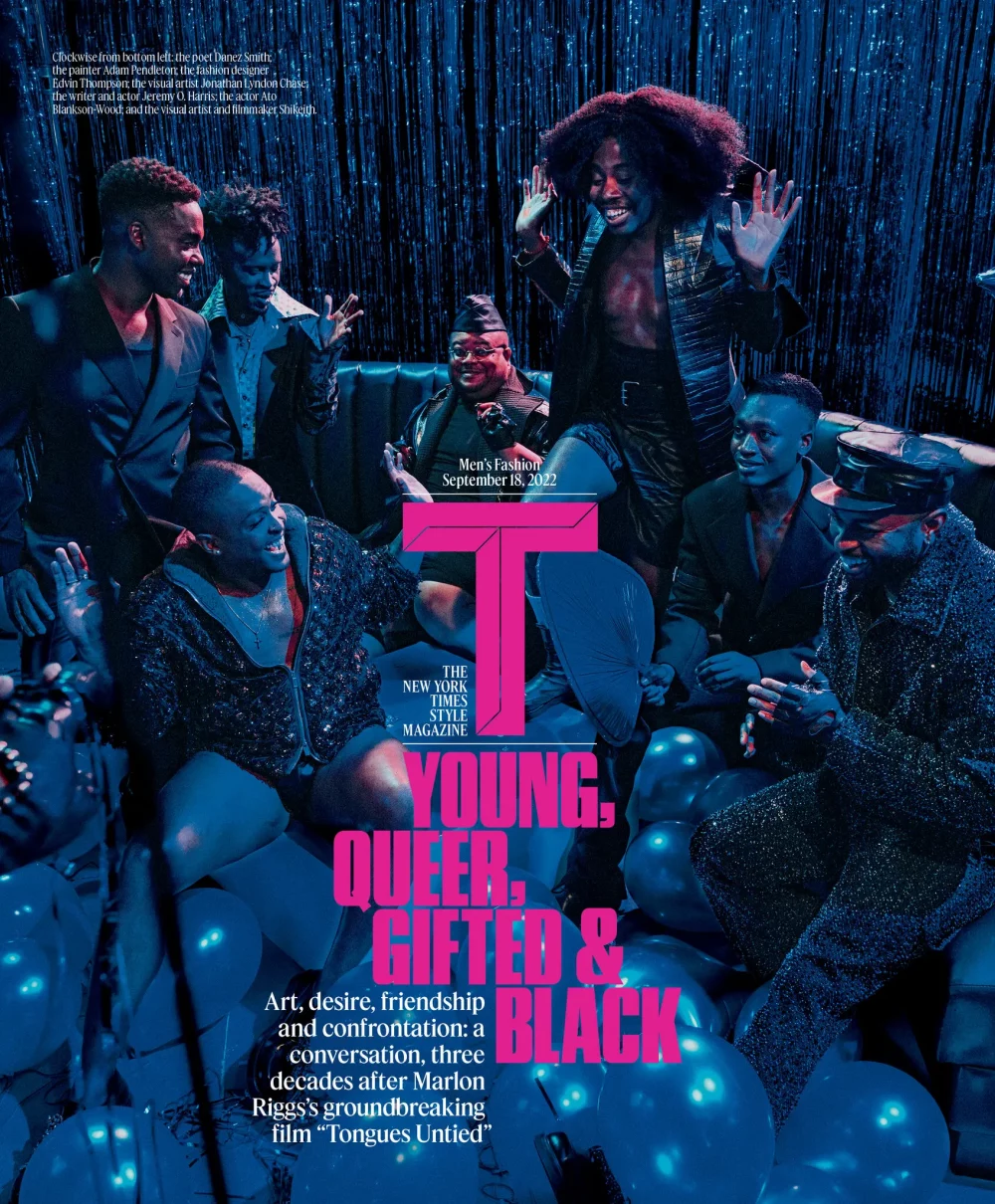
Clockwise from bottom left: DANEZ SMITH; ADAM PENDLETON; EDVIN THOMPSON; JONATHAN LYNDON CHASE; JEREMY O. HARRIS; ATO BLANKSON-WOOD; and SHIKEITH. Photograph by Shikeith. Styled by Ian Bradley
D.S.: What I’m also hearing is what has happened when the state decides that artists aren’t risky. We have a great privilege being artists in this country because we don’t hear about our colleagues having to live in exile, being in prison. You write the wrong poem in China, yo’ ass is locked up.⁴⁰ Maybe you, like I, have had your phone tapped a little when you wrote about the cops, but I don’t know what any of this means. Has the government defanged the potential activism — the explosiveness of art — by deciding that art isn’t dangerous?
J.O.H.: It might feel like a defanging, but they’ve just gotten more advanced: I have friends — and you probably do, too — whose books are literally banned in weird libraries all around the country, just because they’re about a gay kid getting married. “That’s a grooming novel”: It starts there. They’re not putting us on trial in a big way anymore. It’s not McCarthyism⁴¹ yet, but it’s going to be if we don’t stay quite woke about what’s happening and keep trying to create tactics of disruption. Everyone who makes art at this table is very likely going to be troubling the waters of the state quite soon if we can’t hold them back, and it’s looking like we’re failing right now.
E.W.: And you see the chipping away, right? It’s “Don’t say gay,” it’s rolling back benefits for trans kids or athletes, it’s the book banning. People aren’t really paying attention to the big picture.
J.O.H.: It’s also because America is so large.
A.P.: So there is a reaction, right? There is a reaction to a room full of people saying, “I’m Black and queer and I’m an artist.” People are saying, “Don’t use the word ‘gay.’ ”
D.S.: That is part of a problem with the largeness of America. It’s like these huge states that could all be their own countries, and a lot of us don’t live in their realities. I’m saying [things] right now that’s from my corner of the universe, but probably wouldn’t be saying [them] if I were a Southern artist.
A.P.: I think we do live in that reality, but the way in which we have to confront it, there’re levels of realness: It’s not like someone’s taking my license and passport and saying, “I saw you in that article, you’re not traveling anymore. You’re a threat.” I still live in that reality, but my immediate body politic, as far as I can conceive it, isn’t necessarily immediately impacted. So I kind of ignore, which is almost like we’re living in a kind of Surrealist moment.
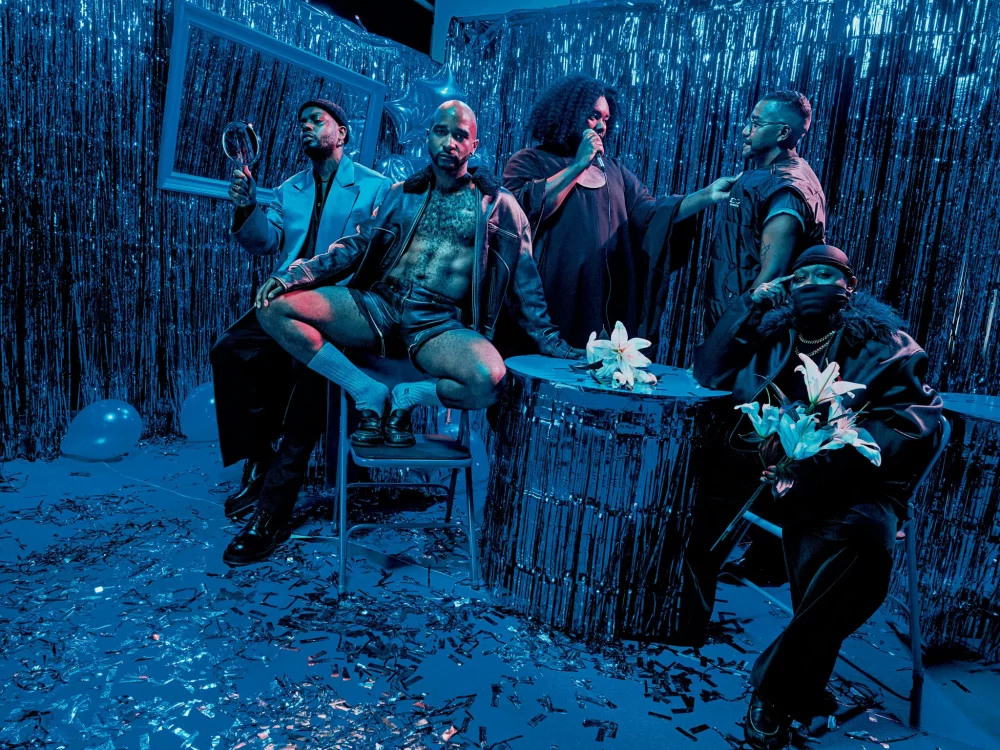
From left: SERPENTWITHFEET, 34, musician; JACOLBY SATTERWHITE, 36, visual artist; TUNDE OLANIRAN, 34, musician, filmmaker and visual artist; TROY MONTES MICHIE, 37, visual artist; TEXAS ISAIAH, age withheld, visual artist. Photograph by Shikeith. Styled by Ian Bradley
J.O.H.: We’re in a [Eugène] Ionesco⁴² play. We’re in multiple plays of his, but mainly “Rhinoceros” right now, where one person is like, “Everyone’s turned into a rhinoceros,”⁴³ and other people are like, “Shut up, it’s totally chill, there’re no rhinoceroses here.” And all of a sudden, everyone’s a rhinoceros at the end of the play. I feel like I’m living “Rhinoceros” right now, but they also think they’re in “Rhinoceros.” That’s the crazy thing. It’s doubly surreal because they’re like, “Wow, every kid’s Black and queer — even the white ones! How did they become Black and queer?”
A.P.: That’s the headline: “Every Kid Is Black and Queer — Even the White Ones!” [All laugh]
J.O.H.: That’s what the Republicans think.
A.P.: That is what they think: They’re literally legislating against it. They’re like, “We’ve got to stop this.”
J.O.H.: Speaking of which, I have a really funny story. I was sitting next to [a French actress at a fashion show in Milan], and someone had just been shot in America and it was very distressing. We were talking about it, and she was like, “You must be so excited to be here in Europe. It’s so free. You walk down the streets, and no one shoots you in the face. It’s so different. You know, you walk in America, you’re on your phone, all of a sudden, ‘boom, boom, boom’ — you’re dead.” I was like, “Um, yeah, I mean, it’s nice to be here. But also, you guys have your own [issues].” She’s like, “No, no, no, we don’t. In France, it’s actually the opposite. It’s much harder to be a white man here than anywhere else. You know, my son, he goes to school and he reads James Baldwin, Toni Morrison, all of these writers. He listens to rap music. And he comes home and he cries, he cries. He says, ‘Maman, maman, why am I not Black? I want to touch girl, but I cannot. Should I just be gay?’ And it’s like, you know, the #MeToo, the Black Lives Matter, it’s put into their brains. They don’t even know who they are. You know, that’s the true oppression in France right now.” And I was like, “What was the name of the first Black president of France?” And she was like, “We have not had one,” and I was like, “Exactly. Call me then.” This is how white nationalism starts — with some liberal lady you think you’re just a vibe with, and she just starts talking crazy because she’s worried her son wants to be Black and gay like the rest of us. Everyone’s turning Black and gay!
S.: That sounds like an episode of “Atlanta.”
E.W.: To wind it up, how do you want to be identified?
A.P.: That’s very easy for me: in and through abstraction.
J.O.H.: I’m going to start thinking of the works that I leave behind as my body — and that’s how I want to be seen, in all of my complexities and hypocrisies and confluences of myself. Because I’m a Gemini, and I’m always going to be contradicting myself all the time. So I want to see that, from my first work that I wrote when I was 17 all the way to whenever I leave.
A.B.-W.: I like this word that I’m going to steal from you, Danez, which is “borderless.” My ability to shape-shift — not only inside of the work, but in my life — my ability to be that free is how I would like to be identified. I hear that word “freedom” so much, but what does that actually mean? “Borderless” seems like a much better term.
D.S.: Black is the thing that comes to mind that I get the most information from and feel the most possibility inside. But I am also queer, poz, American, Minnesotan, all of these things. When folks think about me in relation to those things, sometimes they have been a wealth, sometimes they have been a target. Sometimes they have been prisons or fields. Sometimes they have been useful. And sometimes I didn’t find no use in them. But they were all information that I tried to pull from.
S.: If I did have to think about my identity, my grandmother’s informing everything about me: How I think, how I imagine, how I see through the darkness, how I exist in the darkness, how I talk. I’m just my grandmother’s baby.
¹ Hemphill (b. 1957) released one full-length collection, “Ceremonies: Prose and Poetry” (1992) that was acclaimed for its depictions of Black gay life — and for calling out racism among white gay men. He died of complications from AIDS in 1995.
² In addition to his work as a columnist for “Au Courant,” an L.G.B.T.Q. magazine in Philadelphia, Beam (b. 1954) edited “In the Life: A Black Gay Anthology” (1986), a seminal book of writing by Black gay men. Beam was at work on a second anthology when he died from AIDS-related causes in 1988 — his mother and Hemphill then completed and published it as “Brother to Brother: New Writings by Black Gay Men” (1991).
³ In his television special “Delirious” (1983), Murphy (b. 1961) says gay men “aren’t allowed to look at my ass while I’m onstage. That’s why I keep moving while I’m up here — you don’t know where [their] section is.”
⁴ Buchanan called the film “blasphemous” and said of the N.E.A., “When I get to be president, we’re going to shut that place down, then padlock it and fumigate it.”
⁵ Shikeith (b. 1989), who holds an M.F.A. in sculpture, recently exhibited video, photography and blown-glass pieces in a solo show at New York’s Yossi Milo gallery.
⁶ Harris (b. 1989) wrote “Slave Play” (2018), which to date has earned the most Tony nominations of a nonmusical play. He also co-wrote the 2021 film “Zola” (2021) and appears onscreen in Netflix’s “Emily in Paris” (2020-present).
⁷ Smith (b. 1989) came to poetry through the slam community and is a two-time finalist in the World Poetry Slam. Their first book, “[Insert] Boy” (2014), won a Lambda Literary Award.
⁸ “please, don’t call / us dead,” reads the opening poem of the collection, Smith’s second. “call us alive someplace better. / we say our own names when we pray.”
⁹ Pendleton (b. 1984) draws on many sources in his work, from protest posters to writings by Toni Morrison, calling his conceptual approach Black Dada.
¹⁰ A fixture of the Bay Area queer community, Purnell (b. 1982) has written zines and novels, founded a dance company and performed with the electroclash band Gravy Train!!!!
¹¹ The collagelike paintings that Chase (b. 1989) makes are held in the collections of New York’s Whitney Museum of American Art, the Los Angeles County Museum of Art and the Philadelphia Museum of Art.
¹² Blankson-Wood (b. 1984) has also appeared in Kathryn Bigelow’s “Detroit” (2017), Spike Lee’s “BlacKkKlansman” (2018) and Ava DuVernay’s “When They See Us” (2019).
¹³ Wilbekin (b. 1967) was the editor in chief of Vibe from 1999 to 2004. He’s since covered pop culture for dozens of outlets and in 2016 founded Native Son, an advocacy group focused on uplifting and connecting queer Black men.
¹⁴ Many scholars believe that Hughes (b. 1901; d. 1967) was gay. After his death, his estate took issue with the 1989 film “Looking for Langston,” which positioned the writer as a Black gay icon, and required a number of his poems to be removed from the work, though it has since not barred the inclusion of his writings in queer-focused anthologies.
¹⁵ Nugent (b. 1906; d. 1987) wrote and made illustrations that dealt openly with homoerotic and interracial desire. His short story “Sahdji” (1925) is the earliest known gay text by a Black American writer.
¹⁶ Smith grew up in St. Paul, Minn., and graduated from the University of Wisconsin — Madison.
¹⁷ Bradley (b. 1985), who is Black, has also styled for Thom Browne, Telfar and Nike.
¹⁸ Jones (b. 1985) is the author of a memoir, “How We Fight for Our Lives” (2019), and a poetry collection, “Prelude to Bruise” (2014).
¹⁹ Williams (b. 1986), a poet, is the author of “Thief in the Interior” (2016) and “Mutiny” (2021) and teaches at New York University and Randolph College in Lynchburg, Va.
²⁰ Smith (b. 1992) is an artist and writer whose performance pieces have been shown at venues including New York’s Solomon R. Guggenheim Museum and MoMA PS1.
²¹ Eastman (b. 1940; d. 1990) made minimalist works, often with provocative titles such as “Gay Guerrilla” (1979) and “If You’re So Smart, Why Aren’t You Rich?” (1977). The composer and singer spoke of his desire to be “Black to the fullest, a musician to the fullest, a homosexual to the fullest.”
²² The “hyperqueer revenge fantasy,” as it was billed in promotional materials ahead of its scheduled opening at New York’s Playwrights Horizons in May 2020, was postponed because of Covid and has not been rescheduled.
²³ Harris spent most of his childhood in Martinsville, Va., with a brief stint in Fort Bragg, N.C.
²⁴ Himes (b. 1909; d. 1984) published his first novel, “If He Hollers Let Him Go,” in 1945 but did not achieve wide recognition until the ’50s, when he emigrated to France and began writing his “Harlem Detectives” series.
²⁵ Shikeith’s first monograph, released in August by Aperture, is titled “Notes Towards Becoming a Spill” and explores the “intangible presences that haunt [Black men’s] bodies and psyches.”
²⁶ From a 1970 profile of the Black fashion designer Howard Davis: He’s “on to something much larger than ego. It’s called culture and to him, that’s the real trip.”
²⁷ Sales (b. 1948) has been honored by the Smithsonian National Museum of African American History and Culture for her lifetime of civil rights activism, including voter registration efforts with the Student Nonviolent Coordinating Committee (S.N.C.C.) and participation in the 1965 marches from Selma, Ala.
²⁸ In 1965, Daniels, a then-26-year-old seminarian, had been protesting racial discrimination with Sales and others in rural Alabama. The group was jailed and, upon their release six days later, an unpaid special deputy sheriff demanded they “get off [his] property” and shot at Sales. Daniels moved to shield her and died on the spot.
²⁹ In “My Calling (Card) #1 (Reactive Guerrilla Performance for Dinners and Cocktail Parties)” (1986-90), Piper (b. 1948) distributed printed cards in social situations whenever someone made a racist comment. “Dear Friend,” one card started, “I am Black. I am sure you did not realize this when you made/laughed at/agreed with that racist remark.” Since the early 2000s, Piper has refused to let her work be included in all-Black shows, arguing that such siloing further marginalizes Black artists.
³⁰ Abramović (b. 1946) has been active since the early ’70s but is best known for “The Artist Is Present,” the 2010 MoMA blockbuster in which she sat in silence for seven hours a day and held the gaze of one viewer at a time.
³¹ “Tongues Untied” opens with a chorus of voices chanting the phrase “brother to brother.” Beam had published an essay using that as its title in 1986, writing, “Black men loving Black men is a call to action, an acknowledgment of responsibility. We take care of our own kind when the night grows cold and silent.”
³² The hashtag took off on Twitter in early 2011 as a way to air grievances without naming names: “#oomf didn’t text me back … smh!”
³³ Julien (b. 1960), the British director of “Looking for Langston,” is an installation artist. He was knighted in 2022 for his contributions to “diversity and inclusion in art.”
³⁴ The CDC’s Morbidity and Mortality Weekly Report noted in July 2021 that African American/Black men who have sex with men have a 50 percent lifetime risk of H.I.V. infection.
³⁵ The conservative push to defund public broadcasting was only mildly successful, with a small decrease in federal funding the following year and then increases thereafter.
³⁶ Senator Jesse Helms of North Carolina in 1992: “Now this program, without any question whatsoever, blatantly promoted homosexuality as an acceptable lifestyle. It showed, what should I call it? I will be kind. It shows homosexual men dancing around naked.”
³⁷ Harris also organized two “Black Out” nights for “Slave Play,” in 2019 and 2020, which were expressly for Black-identifying audience members. Several other theater productions have since staged their own Black Outs.
³⁸ The Yale School of Drama offers this lecture series “to make students aware of current discussions in theater and performance studies that necessarily lie outside the program’s core curriculum.”
³⁹ In 2014, several Russians demonstrating for the release of political prisoners were arrested for holding what they referred to as “invisible placards” near the Kremlin.
⁴⁰ The Uyghur poet Gulnisa Imin is currently serving a 17-and-a-half-year prison sentence in Kashgar, China, reportedly for promoting “separatism” in her work.
⁴¹ Senator Joseph McCarthy’s campaign to identify Communist sympathizers in the late ’40s and early ’50s often cratered the careers of blacklisted individuals, many of whom worked in Hollywood. Among his targets was Hughes, who in 1953 was subpoenaed to testify about his political affiliations.
⁴² The Romanian French playwright (b. 1909; d. 1994) was a central figure in what came to be known as Theatre of the Absurd, which produced works emphasizing the meaninglessness of life in postwar Europe.
⁴³ “It’s all a hoax,” one character says in “Rhinoceros” (1959). “I can’t see a thing. It’s an illusion.”

